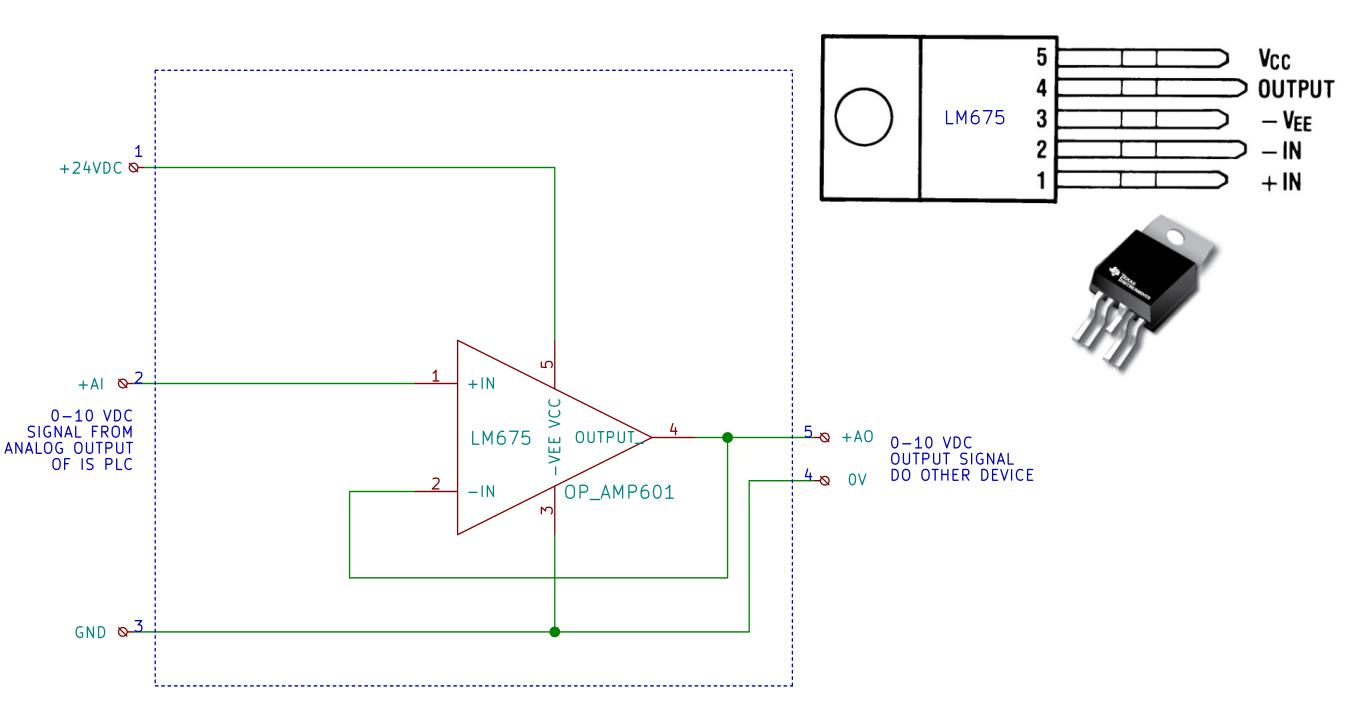Why stronger Analog Output?
PLCs from Industrial Shields are capable to give you a 20mA from analog output. For most devices, which just need a reference voltage signal (like VFD [Variable Frequency Drives, or Inverters]), is this enough. But there are also devices, which can be controlled by analog signal, but with higher current demand. Like some kinds of hydraulic valves. Yes, some valves are also transforming analog signal (0..10VDC) to PWM using their own circuits, but also these (as I have measured) are demanding up to 100 mA. Also there are valves, which need almost 500 mA for positioning of their spool.
So here we need a little help to prevent damage of our PLCs.
Well, if you're asking, why there is just 20 mA limit, take in mind, that some producers allow just 12 mA, 18 mA, or 25 mA. So 20 mA is a common value.
Voltage follower using Op-Amp
Yes, voltage follower using op-amp (operation amplifier) is your friend. Voltage follower, as the name says, is a circuit, which has on output the same voltage as on input. The op-amp has many ways of connection, for various purposes, usually as amplifier (with open or closed loop, differential, summing, oscillator…). The construction is usually as integrated circuit, but can be also discrete, especially like the one, I want to introduce, which also has mounting hole for cooler (if needed).
So we will use op-amp LM675 (datasheet) by Texas Instruments, but can be used any other, just what is important, is its current capability, which defines max. current, which can be feeded by this device.
This LM675 is suitable for valves, servos, …, everything up to 3 A and max. 60 V.
Can be used for AD and DC applications, but for our purpose we need to think just in DC margins, as we have just positive voltage from 0 to 10 VDC.
Every op-amps has a power-supply pins, marked as Vs+ and Vs- or VCC and -VEE.
The tested circuit from QUCS looks:

As you can see:
(Of course, your power supply must be able to give enough Amps for regulated device.)
So the output graphs are as expected:

So - blue curve is the output from Industrial Shields analog output; red curve is the output from the op-amp, which can go into your device (hydraulic valve, …). The output copies the input.
The scheme of PCB is more-less the same as simulation scheme.
Note, that because we have just DC signal (so just positive voltage), the -VEE must be connected to ground.
Most power amplifiers do not drive highly capacitive loads well, and the LM675 is no exception. If the output of the LM675 is connected directly to a capacitor with no series resistance, the square wave response will exhibit ringing if the capacitance is greater than about 0.1 μF. The amplifier can typically drive load capacitances up to 2 μF or so without oscillating, but this is not recommended. If highly capacitive loads are expected, a resistor (at least 1Ω) should be placed in series with the output of the LM675. A method commonly employed to protect amplifiers from low impedances at high frequencies is to couple to the load through a 10Ω resistor in parallel with a 5 μH inductor.

Hope this can help someone facing the problem with demand for higher, stronger analog output.
Posts in this text are provided "AS IS" with no warranties, and confers no rights.